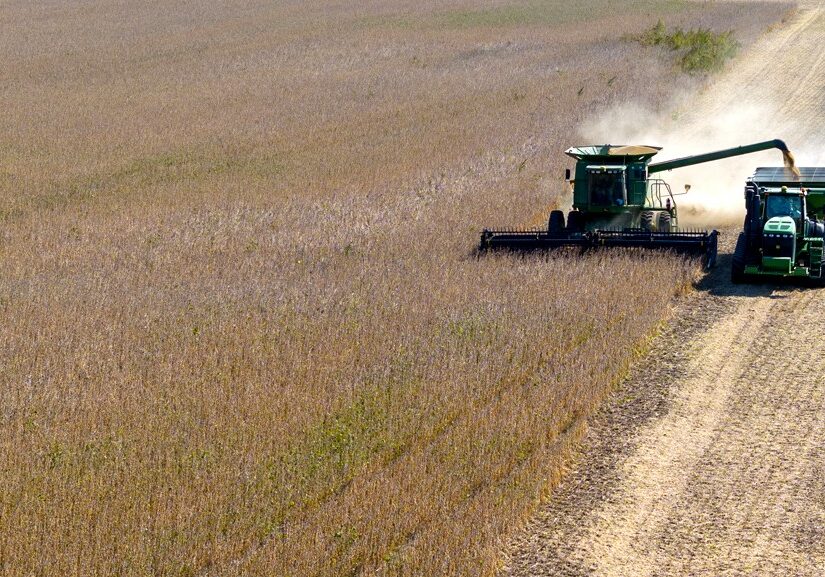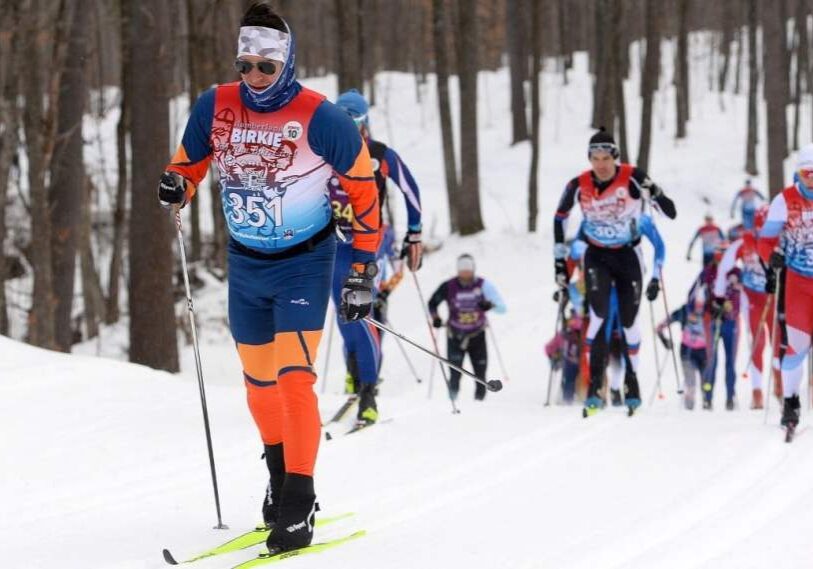Conservation Conversation with Farmer Duane Bakke
From farm kid to starting out on his own

This article is the first in a series focusing on conversations about conservation with southeastern Minnesota farmers, landowners and conservationists.
PRESTON TOWNSHIP, FILLMORE COUNTY – Farmer Duane Bakke has devoted his 47-year farming career to conservation through multiple practices, methods and programs.
Bakke grew up on a diversified farm near his current residence where his family milked cows, raised pigs and beef cattle, and rotated crops of oats, hay and corn. After graduating high school, he enrolled at the University of Minnesota-Twin Cities and eventually came back to southeastern Minnesota to try farming on his own.
In 1979, Duane rented a farm east of Highland, Minn. In 1984, he and his family moved to their current location south of Lanesboro and were able to make a down payment on this farm in 1990. He started by raising pigs and a few beef cows and he first began no-till planting of soybeans in 1987.
Duane hired someone to drill the soybeans into corn stubble, and he credits that individual for introducing him to no-till farming. While trying to start a farm in the 1980s was very difficult, Duane kept with it and gives credit to his wife, Angel, who worked at Mayo Clinic for 42 years to help support their young family of four.

The first no-till drill Bakke purchased with a friend is a Tye 2015, which is 15’ wide. This equipment was essential to continue his no-till farming practices. (Photo by Alison Leathers)
Choosing conservation
No-till farming means the soil is not tilled or turned over to prepare for planting. The seeds are directly planted into the untilled soil using a special planter, which means they are planted into the ground with previous years’ crop residue.
Duane has been a 100% no-till operation for 20-plus years, using a rotation of corn and soybeans with winter rye cover crops planted after the soybeans are harvested.
He knows his landlords really like this rotation because it has reduced soil erosion and improved their land. He’s noticed that in the last 10 to 15 years, no-till farming has been promoted and researched even more.

Popping up in between the soybean rows is last year’s corn crop residue. The John Deere planter cut through this residue to plant this year’s soybean crop. (Photo by Alison Leathers)
Duane has adopted many other conservation practices over the years since starting with no-till. He still uses the Tye 2015 drill to plant his cover crop of winter rye each season, which he started doing around the year 2000.
Using cover crops, like winter rye, is another important conservation practice used on the farm. Winter cover crops help reduce soil erosion, hold in moisture for the soil, reduce weeds and add organic matter into the soil.

The current John Deere 1770NT CCS 12-row planter Bakke uses to fertilize and plant no-till corn and soybeans. (Photo by Alison Leathers)
Another practice Duane started implementing around 2010 is planting and maintaining Conservation Reserve Program (CRP) acres. This program is a federal program through the USDA’s Natural Resource Conservation Service (NRCS), where landowners enroll in the program, plant perennials like native grasses and herbaceous, pollinator friendly-plants and receive a payment from the USDA for 10 to 15 years.
Duane has convinced some of his landlords to plant CRP in marginalized areas around woods; where there is poor ground to plant; and where there is steeper ground prone to erosion.
He plants specific CRP mixes that include plant species favorable for quail habitat and pollinators like bees and butterflies. The landlords have appreciated this encouragement from Duane as they see the benefits CRP provides such as reduced soil erosion and creating wildlife habitat. CRP requires maintenance and Duane keeps up through spot mowing to remove weeds or trees. He either mows in the fall or mows early in the spring before the nesting season for turkeys, quails and pheasants.
As you drive around Southeast Minnesota in the spring, you may notice controlled burns of CRP or prairies, which is an effective way to maintain these perennial lands and prevent weeds or trees from taking over. Duane contacted someone to do a controlled burn in 2025 but it was too windy to get it done. He plans to try again in Spring of 2026.

In the middle of the photo is a grass waterway planted in the midst of the soybeans and corn to help prevent soil erosion. (Photo by Alison Leathers)
He carefully calculates how much nitrogen fertilizer needs to be applied to corn, even calculating how much nitrogen last year’s soybeans may have added to the ground through fixation. The first nitrogen application is done with the post-plant herbicide spray.
Following this, a second application is completed approximately a month later with side dressing, by injecting nitrogen into the soil between the corn rows. This helps ensure the efficient use of fertilizer and follows all Minnesota rules for nitrogen application.
Duane also uses other conservation methods such as planting and maintaining grass waterways in the fields for water to flow off the field with less erosion. He also uses contour planting – which is planting along with the topographic contours of the field – to reduce soil erosion.
Practicing these various conservation methods has allowed Duane to sustain his farming career along with the acres he is responsible for, and he continues to learn through, “reading articles from farming magazines and online”.

The soybeans pods are checked by Duane to see how many beans are in a pod. (Photo by Alison Leathers)
The ground becomes a sponge
Witnessing first-hand the benefits of these conservation practices was pretty immediate for Duane. “The ground just becomes a sponge,” he shared. All that organic matter left on the fields allows moisture to be retained because the soil can better absorb moisture from snow melt and rain.
After the wet growing 2025 season, Duane is confident there is enough moisture in the soil now to make it through the rest of the season, especially, he explained, because “the crops are mature enough where they shade the soil to help keep that moisture in.”
No-till farming also has a financial benefit. Duane shared he can spend less money on fuel and other inputs because he does not need to plow or disc the soil before planting.
This also means he has less machinery, and therefore lower machinery costs. He does share, however, that “no-till attachments do cost money,” and that is his main equipment cost.
Knowing how to market your crops is also an important part of the job, which helps lead to financial sustainability. He skillfully strategizes when to sell his crops, by sharing that he “checks cash flow and knows his costs while taking into account his yield.” A big part of his job is marketing his crops.
The middle ground
Duane recognizes that “no-till farming is not for everyone,” especially farmers that have livestock manure that needs to be incorporated into the soil. As Duane states, “farmers are just trying the best they can.”
Throughout his years as a Fillmore County Commissioner, Duane is proud to be “representing the middle ground between farmers and environmentalists.”
His knowledge and background as a farmer, combined with his service to conservation groups like the Root River One Watershed One Plan through the Fillmore County Soil and Water Conservation District, has enabled him to share that middle ground perspective so the needs of farmers and conservation are all considered.

On the left, Bakke pulls off an ear of corn to check moisture and count kernels. On the right, Bakke shows off a nice ear with 20 kernels around and 40 kernels long with some denting. He is optimistic about his crop, but knows one bad weather event or frost could change everything. (Photo by Alison Leathers)
A family affair
Each harvest season, Duane’s family returns to the farm one weekend to help harvest some of the corn and get it into the wet bin, which automatically fills the dryer, then moves the corn into a dry bin for storage.
This day is fun for his wife Angel; adult children, Jade and her spouse Brett; Nick and his spouse, Katie and their grandchildren. It’s an opportunity for them to share some knowledge and experience with their five grandkids and expose them to the ways he farms.

Grain storage bins for the Bakke farm’s corn and soybeans. One is a wet bin that fills the dryer. (Photo by Alison Leathers)
Conservation has been a 47-year commitment for Duane and the acres he stewards to raise crops. He has seen the wonderful benefits of the various conservation practices he implements.
Now he is focusing on helping the next generation of farmers come into the fold and sharing his knowledge and advice with them. Duane’s farm and methods have proven that prioritizing conservation can allow a farm’s land and business to thrive.
Read more about prescribed burns in this Root River Current story, “Prescribed Burn Team Treats State Highway Ditches With a Dose of Fire.”

A prescribed burn in a native grass production field outside of Spring Grove (Photo by Shooting Star Native Seeds)






